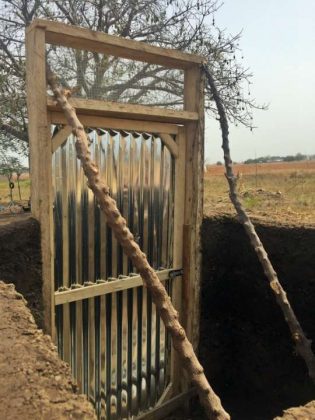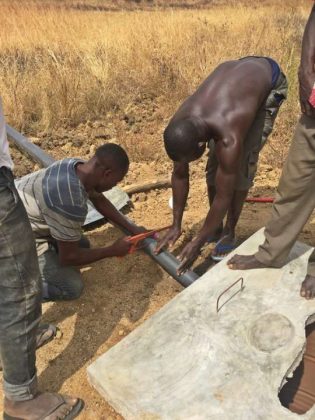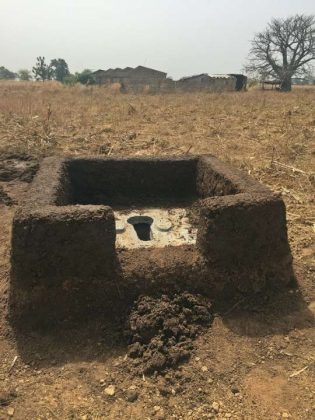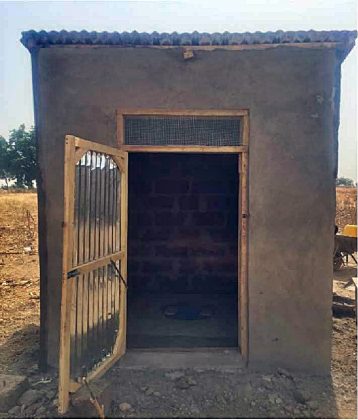This project is made possible through the partnership of WATER CHARITY and the NATIONAL PEACE CORPS ASSOCIATION. ![]()
This project has been completed. Please scroll down the page to read the conclusion.
 Location
Location
Bxxxxxx, Talensi District, Upper East Region, Ghana
This project summary has been redacted for security reasons to omit the specific project location.
Community Description
Bxxxxxx, a farming community of about 2,000 people, is completely dependent on the annual rainy season in this region of Ghana. The community consists of eight ‘sections’ based on clan and sub-clan membership. Farms surround the houses which consist of mud structures with tin roofs.
There is no running water. Borehole wells are strategically interspersed within the community and women and children fetch water from these for cooking and bathing. During the rainy season from May/June through October these subsistence farmers grow maize, millet, peanuts, and beans. Shea trees are plentiful in the bush, and women collect the fruit and nuts to make Shea butter. The period of February through May is sometimes called ‘the hunger season’ when food can be scarce and some families are reduced to one meal a day. There is no farming activity in the long dry season from November to April.
Problem Addressed
While all houses in Bxxxxxx include a bathing area, very few have toilets. Private and sanitary defecation is a major problem. To defecate, people go to nearby fields during the rainy season when the crops offer some privacy, or to the surrounding wild bush areas in the dry season. It is especially difficult for older and sick residents who are forced to relieve themselves in open spaces. As a result, diarrhea and intestinal worms are prevalent, especially among children.
Project Description
This project is to build 24 unlined Ventilated Improved Pit (VIP) toilets. A Community-Led Total Sanitation (CLTS) drive is underway in the designated sections. (The Talensi district led CLTS campaigns in three other sections of the village in 2016 and 2017 and plans to target the remaining three sections in 2019.)
- Dig 24 pits (approximately 9-ft. deep) and install two metal oil drums per pit for reinforcement
- Construct reusable concrete slabs
- Build outer structures surrounding the toilets
Community Organization
Talensi District Environmental Health Officers
Project Impact
Number of people affected by the project: Approximately 110
Monitoring and Maintenance
Households will undergo training on proper latrine use and maintenance covering aspects of health, hygiene best practices, and keeping toilets clean. The PCV and area sanitation committees will carry out subsequent health and hygiene training in the community after project completion. This project uses a sustainable toilet design. The toilet slab will include handles, allowing it to be moveable, and the toilet door will be similarly reusable. When a toilet pit is no longer viable, a new pit will be dug and the concrete slab will be moved to it. The old door will be installed onto the new toilet structure.
 The district is encouraging participating households to organize sanitation committees and set up toilet maintenance funds for each section. The goal of the committees will be to promote hygiene and manage toilet maintenance funds. A small annual contribution per household will support the toilet maintenance funds. While maintenance funds under the planned sanitation committees will cover repairs, the concrete slab is not expected to break easily.
The district is encouraging participating households to organize sanitation committees and set up toilet maintenance funds for each section. The goal of the committees will be to promote hygiene and manage toilet maintenance funds. A small annual contribution per household will support the toilet maintenance funds. While maintenance funds under the planned sanitation committees will cover repairs, the concrete slab is not expected to break easily.
Depending on the number of people using a toilet, a pit latrine can last from three to six years. In the coming years, once a toilet pit is deemed full or unusable, the old pit will be filled in and covered by razing the outer clay structure. The metal drums will decay over time without damage to the environment. The only waste would be from a PVC pipe at the old site (if not reused), and the cement used to plaster the outer structure.
Let Girls Learn
Improved sanitation and hygiene lead to better health for all children and allows for fewer missed school days and better learning.
Peace Corps Volunteer Directing Project
Maha Patrick
Project Funding
This project has been funded by an anonymous donor.
Conclusion of Talensi District Latrine Project – Ghana
This project has been completed under the direction of Peace Corps Volunteer Maha Patrick.
 The project was designed to build 24 unlined Ventilated Improved Pit (VIP) toilets.
The project was designed to build 24 unlined Ventilated Improved Pit (VIP) toilets.
Maha reports:
This project successfully constructed twenty-two metal drum-lined ventilated improved pit (VIP) toilets in various locations throughout the community. Two metal oil drums were used for reinforcement, per pit. Toilets were designed and constructed so that concrete slabs and wooden doors could be reused in the future. Outer structures were built to provide privacy and Tippy Taps were installed to reinforce hand washing and basic hygiene practices.
The construction of the twenty-two VIP toilets has sparked interest in the entire community for well-built and durable VIP household latrines.
The construction of household latrines represents a positive step towards comfort, convenience, and better health for the participating households and community. The construction of VIP toilets has resulted in a greater number of community families interested in securing the advantages of having their own household toilets. While twenty-two VIP toilets are not enough to achieve an open defecation-free status, which is the primary goal of Community-Led Total Sanitation Projects, the community has benefited greatly and is hoping to build more VIP toilets in the future.
We extend our thanks to Maha for completing this important project.